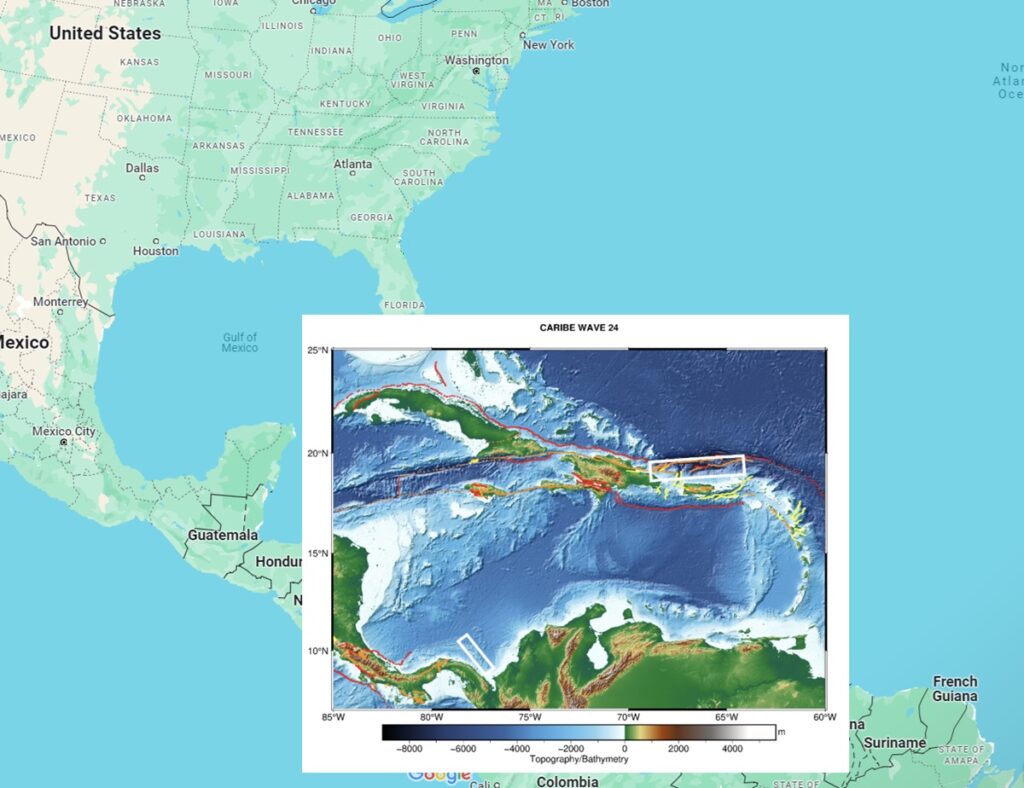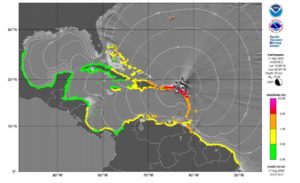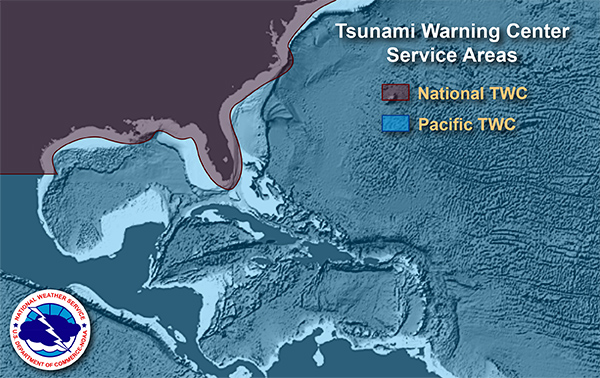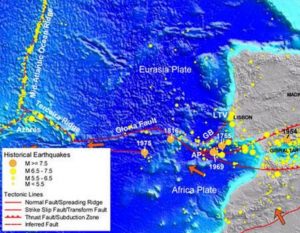

A significant earthquake and tsunami simulation will unfold on March 21 this year as part of the Caribe Wave 2024 drill. Caribe Wave is the annual tsunami exercise that 48 countries and territories participate in, giving forecasters and first responders a comprehensive simulation and drill to prepare them for a potential real threat in the future. While most associate tsunami threats with the Pacific basin, officials are preparing for the possibility of similar seismic activity in the Atlantic basin that could threaten the U.S. East Coast and the Caribbean by launching multiple drills.
For 2024, two different scenarios will be simulated. Each participating country will select a scenario that best fits their objectives. The first scenario simulates a tsunami generated by a magnitude 8.7 earthquake located in the Puerto Rico Trench. The second scenario simulates a tsunami caused by a magnitude 8.4 earthquake located on the Northern Panama Deformed Belt.
At 9am ET, the Pacific Tsunami Warning Center will roll-out the simulation.
While the Caribe Wave ’24 simulations will be sharing earthquake and tsunami advisory and warning information among officials, none of it should be released to the public. However, test messages will have the following text added in the event they do somehow end up in public channels:
...THIS MESSAGE IS FOR TEST PURPOSES ONLY... ...TEST TSUNAMI THREAT MESSAGE TEST... **** NOTICE **** NOTICE **** NOTICE **** NOTICE **** NOTICE ***** THIS IS A TEST MESSAGE. THIS MESSAGE IS ISSUED FOR INFORMATION ONLY IN SUPPORT OF THE UNESCO/IOC TSUNAMI AND OTHER COASTAL HAZARDS WARNING SYSTEM FOR THE CARIBBEAN AND ADJACENT REGIONS AND IS MEANT FOR NATIONAL AUTHORITIES IN EACH COUNTRY OF THAT SYSTEM. THIS IS A TEST MESSAGE. NATIONAL AUTHORITIES WILL DETERMINE THE APPROPRIATE LEVEL OF ALERT FOR EACH COUNTRY AND MAY ISSUE ADDITIONAL OR MORE REFINED INFORMATION. **** NOTICE **** NOTICE **** NOTICE **** NOTICE **** NOTICE *****
Joining the tsunami drill will be U.S.-based National Tsunami Warning Center and the Pacific Tsunami Warning Center. The National Tsunami Warning Center is responsible for the U.S. East and Gulf Coasts while the Pacific Tsunami Warning Center area of responsibility includes much of the Caribbean, Central America, and portions of northern South America.

Months later, on March 23, another significant earthquake and tsunami drill will unfold. Unlike the CaribeWave ’22 event which focuses on preparedness in the Caribbean, the March 23 LANTEX 22 drill is designed to prepare the rest of the North American Coast for tsunami dangers.
While Caribe Wave ’24 will focus on threats from the Caribbean Sea, the rest of the Atlantic U.S. and Canada will participate in another drill known as Lantex ’24 in November. The November 7 drill will allow other emergency managers across the U.S. East and Gulf Coasts and eastern Canada to prepare and rehearse for the possibility of damaging earthquakes and tsunami there too.
As an example, in the Lantex ’21 drill, a Tsunami Warning was “issued” for coastal areas of Newfoundland and Labrador from Cape Ray, Newfoundland to Cape Chidley, Labrador while a Tsunami Advisory was “issued” for Florida, Georgia, South Carolina, North Carolina, Virginia, Maryland, Delaware, New Jersey, New York, Connecticut, Rhode Island, Massachusetts, New Hampshire, Maine, New Brunswick, Nova Scotia and the balance of the North American east coast from Cape Ray, Newfoundland to Flamingo, Florida.
These earthquake and tsunami drills will help bring awareness to the threats these areas could experience, allowing local officials and residents to be ready when an actual threat arrives. (If any real tsunami threat occurs during the time period of the exercise, the exercise will be terminated.)
Tsunamis are giant waves caused by earthquakes or volcanic eruptions under the sea. Out in the depths of the ocean, tsunami waves do not dramatically increase in height. But as the waves travel towards land, they build up to higher and higher heights as the depth of the ocean decreases. The speed of tsunami waves depends on ocean depth rather than the distance from the source of the wave. Tsunami waves may travel as fast as jet planes over deep waters, only slowing down when reaching shallow waters. While tsunamis are often referred to as tidal waves, this name is discouraged by oceanographers because tides have little to do with these giant waves.

The National Oceanic and Atmospheric Administration (NOAA) and the U.S. National Tsunami Hazard Mitigation Program (NTHMP) are providing the framework for the Lantex ’24 tsunami exercise, which is being conducted to assist tsunami preparedness efforts throughout the Atlantic region. Recent earthquakes and their associated tsunamis, such as those in Samoa (2009), Haiti (2010), Chile(2010, 2015), and Japan (2011) attest to the importance of proper planning for tsunami response. Similar recent exercises in the Pacific and Caribbean Basins have proven effective in strengthening preparedness levels of emergency management organizations. This exercise will provide simulated tsunami alert messages from the NOAA/NWS National Tsunami Warning Center (NTWC) for the eastern coasts of Canada and the United States as well as Puerto Rico and the US/British Virgin Islands.
The area where the simulation will occur is not a stranger to violent tsunami-generating earthquakes. The Africa-Eurasia plate boundary extends from the Mid-Atlantic ocean ridge triple junction near the Azores eastward to the Strait of Gibraltar. Here, the Africa plate rotates counterclockwise relative to the Eurasia plate at a rate of about 4 mm/year. While that motion is relatively slow compared to other active plate boundaries found elsewhere around the world, several large magnitude earthquakes have occurred here. In 1755, there was a 7.6 magnitude quake there; in 1816, a magnitude 7.6 quake struck here; in 1969, a 7.9 earthquake struck here.
While officials prepare their own systems and communication methods for these drills, it’s important than anyone in a coastal area become familiar with tsunami advisories or warnings that could be issued for their area in the event of a real tsunami threat. The National Weather Service asks that people in any coastal community be familiar with what a Tsunami Warning and Tsunami Advisory are:
Tsunami Warning
A tsunami warning is issued when a tsunami with the potential to generate widespread inundation is imminent, expected, or occurring. Warnings alert the public that dangerous coastal flooding accompanied by powerful currents is possible and may continue for several hours after initial arrival. Warnings alert emergency management officials to take action for the entire tsunami hazard zone. Appropriate actions to be taken by local officials may include the evacuation of low-lying coastal areas, and the re-positioning of ships to deep waters when there is time to safely do so. Warnings may be updated, adjusted geographically, downgraded, or canceled. To provide the earliest possible alert, initial warnings are normally based only on seismic information.
Tsunami Advisory
A tsunami advisory is issued when a tsunami with the potential to generate strong currents or waves dangerous to those in or very near the water is imminent, expected, or occurring. The threat may continue for several hours after initial arrival, but significant inundation is not expected for areas under an advisory. Appropriate actions to be taken by local officials may include closing beaches, evacuating harbors and marinas, and the repositioning of ships to deep waters when there is time to safely do so. Advisories are normally updated to continue the advisory, expand/contract affected areas, upgrade to a warning, or cancel the advisory.
For more information on the U.S. Tsunami Warning system, visit www.tsunami.gov.